Introduction
Tulu culture, deeply rooted in the southwestern coastal region of Karnataka, India, is a vibrant tapestry of unique traditions, customs, and practices. Among its many cherished symbols, the Vavilaku stands out as a beacon of cultural heritage. This traditional oil lamp, integral to Tulu rituals and festivals, transcends its functional role to embody knowledge, prosperity, and spiritual enlightenment. In this comprehensive exploration, we will delve into the significance of Vavilaku in Tulu culture, tracing its historical origins, understanding its cultural importance, and examining its relevance in contemporary times.
Historical Origins of vavilaku in tulu
vavilaku in tulu has been an enduring element in Tulu culture, with its roots extending deep into history. Originating from ancient South Indian traditions, the Vavilaku is believed to have been used in various religious and ceremonial contexts for centuries. Its design and usage have evolved, but its symbolic significance remains intact.
Historically, the Vavilaku was crafted from brass or copper, often with intricate designs reflecting the artisan’s skill and the cultural motifs of the region. It was typically used in temples, homes, and community gatherings, symbolizing a sacred connection between the divine and the mundane.
The Cultural Significance of vavilaku in tulu
Symbol of Enlightenment and Knowledge
In Tulu culture, the Vavilaku is more than just a source of light. It represents enlightenment, both intellectual and spiritual. The lamp is lit during important rituals, festivals, and daily prayers, serving as a reminder of the pursuit of knowledge and wisdom. The light of the Vavilaku is believed to dispel darkness and ignorance, symbolizing the triumph of knowledge over ignorance.
Representation of Prosperity and Good Fortune
The vavilaku in tulu also embodies prosperity and good fortune. Its presence during auspicious events, such as weddings and housewarmings, is seen as a harbinger of success and well-being. The lamp’s glow is thought to attract positive energies and blessings, ensuring a prosperous future for those who light it.
Ritualistic Importance
During Tulu rituals and festivals, the Vavilaku plays a central role. It is often used in traditional ceremonies like “Deepa” (the festival of lights) and “Pookal” (harvest festival), where it is placed on altars and offered during prayers. The ritual of lighting the Vavilaku signifies the invocation of divine presence and the seeking of blessings.
vavilaku in tulu in Modern Times
In contemporary Tulu society, the Vavilaku continues to hold a revered place despite modernization and technological advancements. It remains an integral part of cultural celebrations and religious practices. However, its role has expanded beyond traditional contexts:
Cultural Preservation
Efforts to preserve Tulu culture include the promotion of traditional artifacts like the Vavilaku. Cultural organizations and enthusiasts work to keep the tradition alive by showcasing these lamps in exhibitions, cultural festivals, and educational programs. This not only honors the past but also educates younger generations about their cultural heritage.
Artistic Expression
Modern artisans have embraced the Vavilaku as a medium of artistic expression. Contemporary designs incorporate traditional elements with innovative touches, reflecting both respect for tradition and a desire for creative evolution. These modern Vavilakus are often displayed as decorative pieces, bridging the gap between heritage and modern aesthetics.
Global Recognition
The global interest in diverse cultural practices has brought attention to the Vavilaku beyond its regional context. International cultural exchanges and festivals provide a platform for showcasing Tulu traditions, including the Vavilaku, to a broader audience. This global recognition helps in fostering cross-cultural understanding and appreciation.
Conclusion
The vavilaku in tulu is more than a mere lamp; it is a profound symbol of Tulu culture, embodying the values of enlightenment, prosperity, and spiritual connection. From its historical roots to its role in contemporary society, the Vavilaku remains a cherished emblem of tradition and cultural identity. As Tulu culture continues to evolve, the Vavilaku stands as a testament to the enduring significance of cultural symbols in maintaining a sense of heritage and continuity.
FAQs
What is the significance of the Vavilaku in Tulu culture?
The vavilaku in tulu symbolizes enlightenment, prosperity, and spiritual connection in Tulu culture. It is used in rituals and festivals to represent the triumph of knowledge over ignorance and to attract positive energies and blessings.
How is the Vavilaku used during Tulu festivals?
During Tulu festivals like Deepa and Pookal, the Vavilaku is placed on altars and lit as part of the rituals. It signifies the invocation of divine presence and the seeking of blessings for a prosperous future.
What materials are traditionally used to make a Vavilaku?
Traditionally, Vavilakus are crafted from brass or copper, often featuring intricate designs that reflect the cultural motifs of the Tulu region.
How has the role of the vavilaku in tulu changed in modern times?
In modern times, the vavilaku in tulu continues to be a part of cultural celebrations and rituals. It is also used as a medium of artistic expression and has gained global recognition through cultural exchanges and exhibitions.
Can the vavilaku in tulu be used as a decorative piece?
Yes, contemporary designs of the Vavilaku often incorporate traditional elements with modern touches, making it a popular decorative piece in addition to its traditional uses.
What are some common rituals involving the vavilaku in tulu?
Common rituals involving the Vavilaku include lighting it during prayers, ceremonies, and festivals to symbolize the dispelling of darkness and the welcoming of divine light.
Why is the vavilaku in tulu considered a symbol of prosperity?
The vavilaku in tulu is believed to attract positive energies and blessings, making it a symbol of prosperity and good fortune. Its presence during significant events is thought to ensure a successful and prosperous future.
How does the vavilaku in tulu contribute to cultural preservation?
The Vavilaku contributes to cultural preservation by being showcased in cultural exhibitions, festivals, and educational programs. It helps in keeping Tulu traditions alive and educating future generations about their heritage.
What are some modern innovations in Vavilaku design?
Modern innovations in Vavilaku design include the incorporation of contemporary artistic elements while maintaining traditional motifs. These designs often reflect both respect for heritage and a desire for creative evolution.
How can people outside of Tulu culture learn more about the Vavilaku?
People outside of Tulu culture can learn more about the Vavilaku through cultural exhibitions, festivals, and educational programs that highlight Tulu traditions. Online resources and cultural exchanges also provide valuable insights into the significance of the Vavilaku.



